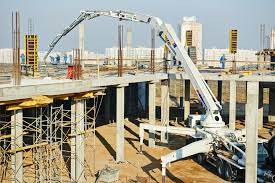Skyscrapers, bridges, and industrial complexes are large-scale construction projects that necessitate precision, efficiency, and impeccable planning. Commercial pumping is an important aspect of these projects that often goes unnoticed by the general public. Commercial pumping is critical to ensuring that these massive projects come together smoothly. In this comprehensive guide, we will investigate the role of commercial pumping in large-scale construction projects, including its significance, the various types of pumps used, and best practices for success.
The Value of Commercial Pumping
For several reasons, commercial pumping, specifically concrete pumping, is essential in large-scale construction projects:
- Quickness and Efficiency
Massive amounts of concrete are typically used in large-scale construction projects visit our website. Concrete pumps, for example, enable the rapid and accurate placement of concrete from the mixer truck to the desired location. This increased efficiency reduces construction timelines and labor costs significantly.
- Accurate Positioning
Precision is essential when working on large-scale projects. Commercial pumps can precisely place concrete, grout, or other materials, ensuring consistency and structural integrity. Precision is essential for tasks such as forming columns, beams, and foundations.
- Availability
Large construction sites frequently have difficult terrain or necessitate the placement of concrete at great heights. Commercial pumps can easily reach these hard-to-reach areas, increasing the versatility and flexibility of construction planning.
- Labor Productivity
Manual concrete pouring can be time-consuming and physically demanding, especially on large projects. Commercial pumping reduces the need for manual labor, increasing worker safety and productivity.
- Cost-Cutting Measures
While purchasing or renting commercial pumping equipment requires an initial investment, the long-term cost savings are significant. Labor savings, reduced material waste, and shorter construction timelines all contribute to cost-effectiveness.
Commercial Pump Types
Commercial pumps of various types, each designed for a specific purpose, are used in large-scale construction projects. The following are some of the most common commercial pumps:
- Pumps for Concrete
The workhorses of large-scale construction are concrete pumps. They are classified into two types: boom pumps and line pumps.
– Pumps for Booms
Boom pumps use an articulated robotic arm (the boom) to reach the desired location. They are ideal for projects that necessitate the placement of concrete at significant heights or distances. Boom pumps are popular for high-rise buildings and large structures because of their precision and versatility.
– Pumps for Lines
Line pumps, also known as trailer pumps, are more compact and suitable for applications at ground level or at a lower height. They transport concrete from the mixer to the job site using flexible hoses. Line pumps are commonly used for foundation and flooring work.
- Grout Pumps
Grout pumps are used to move grout, which is a fluid mixture of cement, sand, and water. They are essential in large-scale construction for grouting applications such as filling gaps between concrete elements or anchoring structures.
- Mortar and Pestle
Mortar pumps are specialized pumps that transport mortar, a mixture of cement, sand, and water. They are frequently used in large construction projects for bricklaying, plastering, and rendering.
- Slurry Pumps
Slurry pumps are used to transport slurry, which is a semi-liquid mixture of water and solid particles. Slurry pumps are essential in large-scale construction for tasks such as dredging, tunneling, and waste management.
Considerations for Safety
Safety is of the utmost importance in large-scale construction projects involving commercial pumping. The following safety considerations must be addressed to ensure the well-being of workers and the success of the project:
- Education and Certification
To operate commercial pumps safely, operators and crew members must receive proper training and certification. They should be well-versed in the operation and safety procedures of the equipment.
- Inspection and Maintenance
Inspect and maintain commercial pumping equipment on a regular basis to ensure it is in good working order. Accidents and project delays can be caused by faulty equipment.
- Protect the Work Area
Before you begin commercial pumping operations, make sure the work area is secure and that unauthorized personnel are kept at a safe distance. Accidents can be avoided by using barricades and warning signs.
- Correct Hose Handling
Hose handling necessitates caution and attention. Kinks and sharp bends in the hoses should be avoided as they can cause blockages or hose bursts. A smooth and safe pumping process is ensured by proper hose management.
- Personal Protective Equipment (PPE)
All commercial pumping personnel should wear appropriate personal protective equipment, such as hard hats, gloves, safety glasses, and steel-toed boots.
- Communication
It is critical that the pump operator, the concrete delivery crew, and the construction team communicate effectively. Clear signals and a well-coordinated effort can help to avoid accidents and ensure accurate material placement.
Best Commercial Pumping Practices
Consider the following best practices to maximize the benefits of commercial pumping in large-scale construction projects:
- Plan and Coordinate
Extensive planning and coordination are required, especially when working with a professional service like https://encoreconcretepumping.com/. Determine the best placement points and paths for the pump while keeping obstacles and site conditions in mind. It is critical that all project stakeholders communicate clearly.
- Select the Proper Pump for the Job
Choose the appropriate commercial pump for the job at hand. The selection of boom pumps, line pumps, or other specialized pumps should be based on the project’s requirements.
- Ensure Correct Mix Design
Cooperate closely with your supplier to ensure that the concrete or other materials pumped are appropriate for the equipment and project. The mix should be consistent and flowable enough for the task
- Monitor Pump Pressure
Maintain proper pump pressure throughout the operation to avoid clogs or hose bursts. During pumping, adjust the pressure as needed.
- Cleaning and Maintenance
After you’ve finished pumping, thoroughly clean the equipment to avoid material buildup and clogs. Proper maintenance ensures that your commercial pumps last a long time.
- Quality Control
Inspect the materials being pumped on a regular basis for consistency and quality. Address any issues as soon as possible to avoid interruptions in the pumping process.
Conclusion
Commercial pumping is an important part of large-scale construction projects because it provides efficiency, precision, and versatility. Whether it’s concrete for high-rise buildings or grout for anchoring structures, commercial pumping plays an important role. Construction teams can harness the full potential of commercial pumping to ensure the success of their ambitious projects by understanding the various types of commercial pumps, prioritizing safety, and adhering to best practices. Visit the Encore Concrete Pumping’s website to learn more about their specialized services in commercial pumping. When commercial pumping is done correctly, it contributes to shorter timelines, cost savings, and the realization of awe-inspiring structures that shape our urban landscapes.



